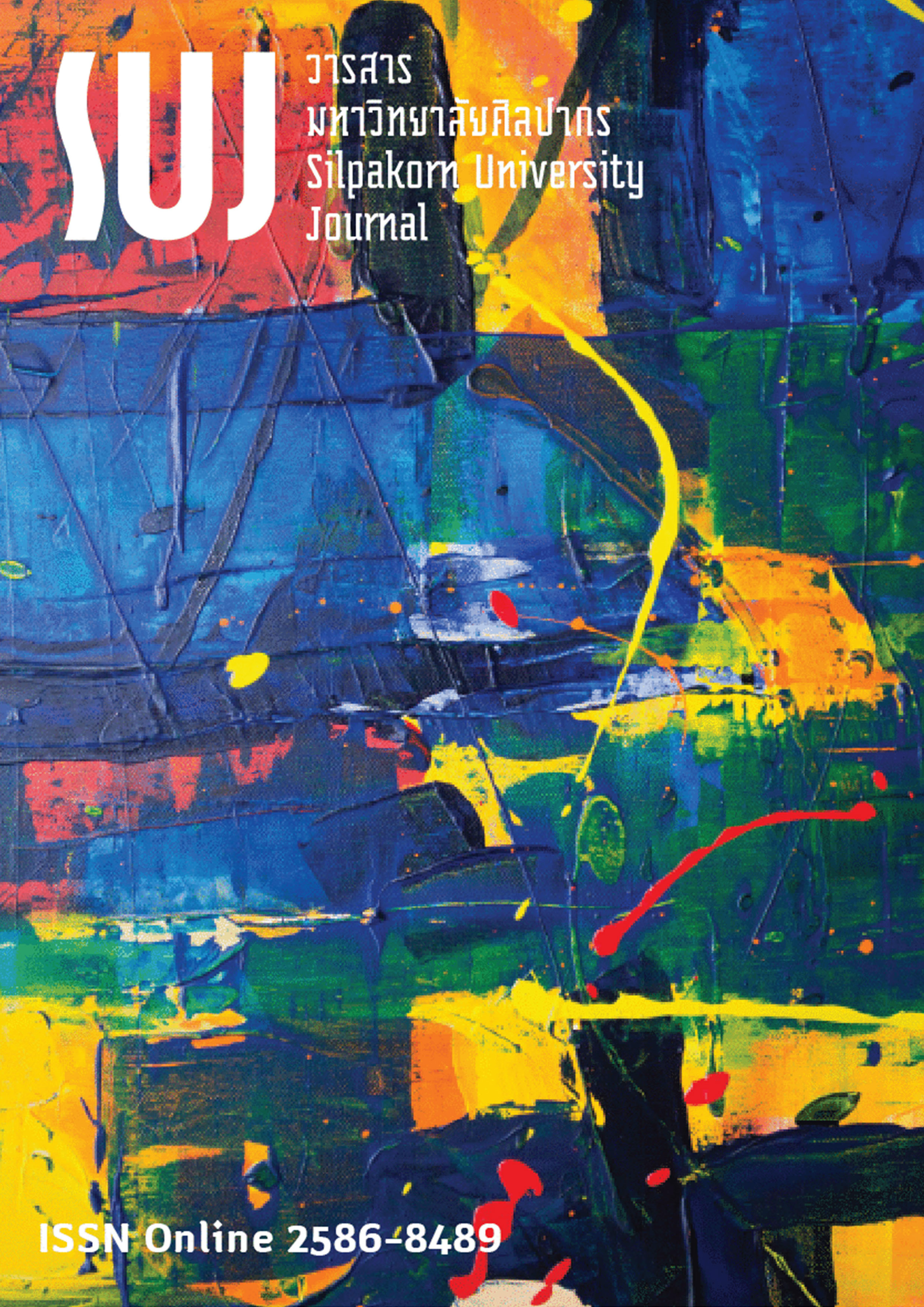การศึกษาลักษณะทางกายภาพของลูกปัดแก้วจากแหล่งโบราณคดีเขาศรีวิชัย อำเภอพุนพิน จังหวัดสุราษฎร์ธานี (The study of the physical characterization of glass beads from Khao Siwichai archaeological site, Phun Phin district, Surat Thani province)
Main Article Content
Abstract
บทความนี้มีวัตถุประสงค์เพื่อศึกษาลักษณะทางกายภาพของลูกปัดแก้วที่พบจากโบราณสถานหมายเลข 3 (เดิม) ในแหล่งโบราณคดีเขาศรีวิชัย ได้แก่ สี รูปทรง ขนาด การตกแต่ง และเทคนิคการผลิต โดยการวิเคราะห์ร่วมกับกล้องจุลทรรศน์อิเล็กตรอนแบบส่องกราด (Field Emission Scanning Electron Microscope; FE-SEM) ผลการศึกษาพบว่า สีของลูกปัดแก้วที่พบในแหล่งโบราณคดีเขาศรีวิชัยมีจำนวน 11 สี ได้แก่ เหลือง ส้ม แดง เขียว ฟ้า น้ำเงิน ม่วง น้ำตาล ดำ ขาว และเส้นสี โดยสีที่พบมากที่สุด คือ สีเหลือง ส่วนการวิเคราะห์ด้านรูปทรง พบรูปทรงลูกปัดแก้ว 8 รูปทรง ได้แก่ ทรงกระบอก (cylinder) ทรงกระบอกสั้น (cylinder disk) ทรงกลมแบน (oblate) ทรงหลอด (tube) ทรงวงแหวน (annular) ทรงกระบอกป่องกลาง (barrel) กลมแป้น (spherical) และทรงมีคอคอด (collared) ซึ่งลูกปัดทรงกระบอก (cylinder) เป็นรูปทรงที่นิยมมากที่สุด ส่วนองค์ประกอบด้านขนาดของลูกปัดแก้ว ผลการศึกษาพบว่า ส่วนใหญ่เป็นลูกปัดขนาดเล็กมาก มีเส้นผ่าศูนย์กลางน้อยกว่า 2.5 มิลลิเมตร และพบเทคนิคการผลิตลูกปัดแก้ว 3 วิธี คือ ลูกปัดแก้วที่ผลิตด้วยวิธีการดึง ซึ่งเป็นกลุ่มที่พบมากที่สุด ลูกปัดที่ผลิตด้วยวิธีการพัน และลูกปัดที่ผลิตด้วยวิธีการหลายขั้นตอน นอกจากนั้น จากการศึกษาเปรียบเทียบกับชุมชนโบราณที่มีอายุก่อนพุทธศตวรรษที่ 19 พบว่า รูปแบบของสี รูปทรง ขนาด การตกแต่ง รวมทั้งเทคนิคการผลิตสัมพันธ์กับลูกปัดแก้วจากอินเดีย ตะวันออกกลาง แหล่งโบราณคดีสมัยทวารวดีในภาคกลางของไทย และแหล่งโบราณคดีหลายแห่งในเอเชียตะวันออกเฉียงใต้ ซึ่งผลจากการวิจัยดังกล่าวสามารถนำมาอธิบายได้ถึงคติความเชื่อ สภาพสังคมวัฒนธรรม เศรษฐกิจการค้า และการติดต่อสัมพันธ์ระหว่างแหล่งโบราณคดีเขาศรีวิชัยกับชุมชนโบราณร่วมสมัยทั้งในภูมิภาคและนอกภูมิภาค นอกจากนั้นผลการศึกษาดังกล่าวยังสามารถใช้เป็นฐานข้อมูลการศึกษาลูกปัดแก้วในภาคใต้ของไทยได้ต่อไปในอนาคต
This article aims to study the physical characteristics of glass beads found at the monument no. 3 (originally) in Khao Siwichai archaeological site, including the color, shape, size, decoration, and production techniques, by analyzing with a Field Emission Scanning Electron Microscope (FE-SEM) for microscopic examination. The results revealed that the glass beads discovered at Khao Siwichai archaeological site exhibited 11 different colors, including yellow, orange, red, green, blue, indigo, purple, brown, black, white, and colored lines. Among these colors, yellow was the most commonly found. The analysis of the bead shapes revealed eight different shapes, namely cylinder, cylinder dish, oblate, tube, annular, barrel, spherical, and collared. Among these shapes, the cylinder shape was the most popular among the glass beads. Regarding the size of the glass beads, the study found that the majority of beads were very small, with a diameter of less than 2.5 mm. In terms of production through pulling, which was the most commonly found method; bead production through winding; and bed production through multiple steps. Furthermore, the study compared the findings with ancient communities dating back to pre-Buddhist era before the 19th century. It revealed that the patterns of color, shape, size decoration, as well as production techniques of the glass beads were similar to those found in India, the Middle East, Dvaravati sites in central Thailand, and various archaeological sites in Southeast Asia. The results of this research can provide insights into beliefs, socio-cultural conditions, trade economies, and interconnections between the Khao Siwichai archaeological sites and contemporary ancient communities both within and outside the region. Furthermore, the findings of this study can serve as a valuable database for future studies on glass bead research in the southern region of Thailand.
Downloads
Article Details

This work is licensed under a Creative Commons Attribution-NonCommercial-NoDerivatives 4.0 International License.
References
Bellina, B., Win, M. S., Htwe, K. M. M., Thu, H. M., Castillo, C., Colonna, C., Dussubieux, L., Favereau, A., Miyama, E., Pradier, B., Pryce, T. O., Srikanlaya, S., & Trivière, E. (2018). Myanmar’s earliest Maritime Silk Road port-settlements revealed. Antiquity, 92(366): e6.
Carter, A. (2010). Trade and exchange networks in iron age Cambodia: Preliminary results from a compositional analysis of glass beads. Bulletin of the Indo-Pacific Prehistory Association, 30: 178-188.
Chaisuwan, Boonyarit, & Naiyawat, Rarai. (2009). Thung Tuk: A Settlement Linking Together the Maritime Silk Route (ทุ่งตึกจุดเชื่อมโยงเส้นทางสายไหมทางทะเล). Songkhla: Trio Creation.
Dubin, L. S. (1987). The History of Beads: From 30,000 B.C. to the Present. New York: Harry N. Abrams.
Dussubieux, L., & Gratuze, B. (2013). Glass in South Asia. In K. Janssens (Ed.), Modern Methods for Analysing Archaeological and Historical Glass, (pp. 399-413). Chichester, West Sussex: John Wiley & Sons.
Dussubieux, L., & Soedewo, E. (2018): The glass beads of Kampai Island, Sumatra. Archaeological and Anthropological Sciences, 10(5): 1129-1139.
Francis, P., Jr. (1991). Beads in Indonesia: A review of the evidence. Asian Perspective, 30(2): 217-241.
Francis, P., Jr. (2002). Asia’s Maritime Bead Trade: 300 B.C. to the Present. Honolulu, Hawaii: University of Hawai’i Press.
Indrawut, Phasuk. (2005). Suvarnabhumi: Based on Archaeological Evidence (สุวรรณภูมิจากหลักฐานทางโบราณคดี). Bangkok: Faculty of Archaeology, Silpakorn University.
Rodcharoen, Putsadee. (2005). A Study on Late Prehistoric Glass from Central and Northeast Thailand Archaeological Sites (การศึกษาแก้วสมัยก่อนประวัติศาสตร์ตอนปลายที่พบในภาคกลางและภาคตะวันออกเฉียงเหนือของประเทศไทย). Master’s dissertation, Silpakorn University, Bangkok, Thailand.
Rodcharoen, Putsadee. (2013). The Analysis of Glass Beads from Dvaravati Ancient Cities in Central Part of Thailand (การวิเคราะห์ลูกปัดแก้วจากเมืองโบราณสมัยทวารวดี ในภาคกลางของประเทศไทย). Doctoral dissertation, Silpakorn University, Bangkok, Thailand.
Samphao-ngoen, Phongthan, & Suksom, Nongkran. (2009). Archaeological Excavation Report of Khao Phra Narai Archaeological Site, Phun Phin District, Surat Thani Province (รายงานการขุดค้นทางโบราณคดี โบราณสถานเขาพระนารายณ์ อำเภอพุนพิน จังหวัดสุราษฎร์ธานี). Bangkok: The Fine Arts Department.
Spaer, M. (1993). Gold-glass beads: A review of the evidence. Beads: Journal of the Society of Bead Researchers, 5: 9-25.
Wang, K.-W., Li, K.-T., Lizuka, Y., Hsieh, Y.-K., & Jackson, C. (2021). Glass beads from Guishan in Iron Age Taiwan: Inter-regional bead exchange between Taiwan, Southeast Asia and beyond. Journal of Archaeological Science: Reports, 35: 102737.


